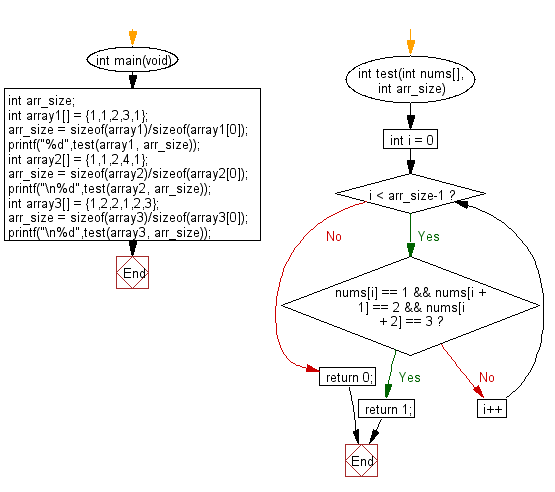How to Read Sequance of Integers C++
C Exercises: Check whether the sequence of numbers 1, ii, 3 appears in a given array of integers somewhere
C-programming bones algorithm: Exercise-fourteen with Solution
Write a C program to check whether the sequence of numbers 1, 2, 3 appears in a given array of integers somewhere.
C Lawmaking:
#include <stdio.h> #include <stdlib.h> int main(void){ int arr_size; int array1[] = {1,1,2,3,1}; arr_size = sizeof(array1)/sizeof(array1[0]); printf("%d",test(array1, arr_size)); int array2[] = {ane,i,2,iv,ane}; arr_size = sizeof(array2)/sizeof(array2[0]); printf("\n%d",test(array2, arr_size)); int array3[] = {1,2,two,1,2,3}; arr_size = sizeof(array3)/sizeof(array3[0]); printf("\n%d",test(array3, arr_size)); } int test(int nums[], int arr_size) { for (int i = 0; i < arr_size-ane; i++) { if (nums[i] == 1 && nums[i + one] == 2 && nums[i + 2] == 3) return 1; } return 0; } Sample Output:
1 0 1
Pictorial Presentation:
Flowchart:

C Programming Code Editor:
Contribute your code and comments through Disqus.
Previous: Write a C plan to check if ii given not-negative integers have the aforementioned final digit.
Next: Write a C program to count the number of two 5'southward are side by side to each other in an array of integers. Likewise count the situation where the second 5 is actually a half-dozen.
What is the difficulty level of this practise?
Examination your Programming skills with w3resource's quiz.
C Programming: Tips of the Twenty-four hours
C Programming - What is the difference between const int*, const int * const, and int const *?
Read information technology backwards (as driven by Clockwise/Spiral Dominion):
- int* - pointer to int
- int const * - pointer to const int
- int * const - const arrow to int
- int const * const - const pointer to const int
Now the first const can exist on either side of the blazon so:
- const int * == int const *
- const int * const == int const * const
If you want to go actually crazy you tin do things like this:
- int ** - pointer to pointer to int
- int ** const - a const pointer to a arrow to an int
- int * const * - a pointer to a const pointer to an int
- int const ** - a pointer to a pointer to a const int
- int * const * const - a const arrow to a const pointer to an int
- ...
And to make sure we are clear on the pregnant of const:
int a = 5, b = 10, c = fifteen; const int* foo; // pointer to constant int. foo = &a; // assignment to where foo points to. /* dummy statement*/ *foo = 6; // the value of a can't get changed through the pointer. foo = &b; // the pointer foo can be changed. int *const bar = &c; // constant pointer to int // note, y'all really need to fix the pointer // hither considering you tin can't change it later ;) *bar = xvi; // the value of c can be changed through the pointer. /* dummy statement*/ bar = &a; // not possible because bar is a constant pointer.
foo is a variable pointer to a constant integer. This lets you change what y'all point to but not the value that you point to. Most often this is seen with C-way strings where you have a arrow to a const char. You may change which cord you indicate to but you can't change the content of these strings. This is of import when the string itself is in the data segment of a program and shouldn't exist changed.
bar is a constant or fixed pointer to a value that tin exist changed. This is like a reference without the actress syntactic carbohydrate. Considering of this fact, usually you would use a reference where you lot would use a T* const pointer unless you need to permit NULL pointers.
Ref : https://fleck.ly/39RctBb
- New Content published on w3resource:
- HTML-CSS Practical: Exercises, Practise, Solution
- Java Regular Expression: Exercises, Practice, Solution
- Scala Programming Exercises, Practice, Solution
- Python Itertools exercises
- Python Numpy exercises
- Python GeoPy Package exercises
- Python Pandas exercises
- Python nltk exercises
- Python BeautifulSoup exercises
- Form Template
- Composer - PHP Package Director
- PHPUnit - PHP Testing
- Laravel - PHP Framework
- Athwart - JavaScript Framework
- Vue - JavaScript Framework
- Jest - JavaScript Testing Framework
Source: https://www.w3resource.com/c-programming-exercises/basic-algo/c-programming-basic-algorithm-exercises-14.php
0 Response to "How to Read Sequance of Integers C++"
Post a Comment